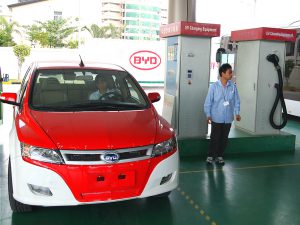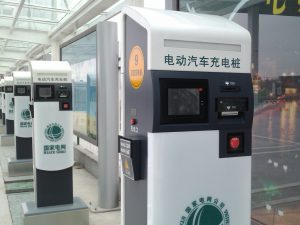The invention of the car a century ago had a profound impact on how we travel. It transformed the way we get to work, to school and even how we enjoy our free time.
We’re now arriving at the next fundamental shift in global transportation. Self-driving cars, coupled with car- and bike-sharing schemes, are expected to have a similarly transformative impact.
Mobility is at a crossroads. Privately-owned cars that can drive themselves will probably improve safety on the roads but they could also worsen congestion and pollution by adding to the number of vehicles in our cities, says Sam Abuelsamid, a senior research analyst at Navigant Research.
“If automated driving isn’t incorporated into shared mobility services that are coordinated with mass transit, it will at best have only a minimal positive impact, and at worst it will make things far worse,” he says.
These issues are coming together most acutely in China, where cities and central government planners are trying to steer people away from polluting cars and towards electric vehicles and public transport.
The promise of autonomy
Private cars are parked 95% of the time or more, taking up enormous amounts of space in cities. But it doesn’t have to be that way, says urban planner Paul Barter.
If cars are shared they can be used around the clock, meaning fewer are needed. This already works for taxis and commercial planes, which have a utilisation rate of 50%.
Fewer cars would free our cities from the burden of providing parking space and, critically, reduce congestion. But not enough thought is going into ensuring that self-driving cars become a shared resource for city dwellers.
Picture zombie cars – those with no one in them – clogging our cities and our roads
Now is the time to be talking about it says Robin Chase, founder of the Zipcar sharing service.
“Simply eliminating drivers from cars – and keeping everything else about our system the same – will be a disaster. Picture zombie cars, those with no one in them, clogging our cities and our roads, because it will be cheaper to keep them moving than to pay for expensive urban parking,” she says.
Are we there yet?
One reason more planning isn’t happening to manage self-driving cars is that nobody is sure how quickly they’ll be adopted.
The Institute of Electrical and Electronics Engineers believes that 75% of vehicles on the road by 2040 will be autonomous.
Meanwhile, the Alliance of Automobile Manufacturers is more cautious, predicting that self-driving cars will not be everywhere “for at least four decades”.
People keep their cars for 10 years or more, so it takes a long time for internal-combustion vehicles to work their way out of the world’s auto fleets.
What’s clear is that the image of passengers sitting in the back seat being chauffeured by a car with no driver is unlikely to be realised in less than ten years. And given the state of current regulation and other potential setbacks, it might be 20 or 30 years.
Susan Shaheen, co-director of the Institute of Transportation Studies’ Transportation Sustainability Research Center at the University of California, Berkeley, says the focus now is on testing the technology, not legalising and regulating it.
She points out that one of the biggest challenges we face, and one that has received little attention is creating a future regulatory framework around zero-occupant vehicles.
“Legislation, regulation and roadway pricing that limits the use of these vehicles may be needed to prevent a world of automated congestion,” says Shaheen.
Regulations will likely come long after our future transportation visions are realised
Technology is racing ahead
We’re only just beginning to understand the implications of vehicle-sharing and autonomous driving. This growing body of knowledge will shape the regulations we develop. But the technology may be moving faster than our ability to regulate it, according to Deborah Gordon, director of the energy and climate program at the Carnegie Endowment for International Peace.
“Regulations will likely come long after our future transportation visions are realised, and their biggest problems become evident. We are generally loathe to regulate before innovation materialises – and very bad at guessing what the biggest problems turn out to be,” she says.
At the forefront of this is ride-sharing services, such as Lyft Line, Uber Pool and the rapidly expanding Waze Carpool. These new entrants fill cars up with passengers for less-expensive trips, and are particularly popular in China, where they could help reduce vehicle congestion in the country’s fast-growing major cities.
John DeCicco, a research professor at the University of Michigan’s Energy Institute, isn’t convinced that ride-sharing will persuade people to abandon car ownership.
“Sharing schemes are going to enable more people to access personal mobility, rather than replacing a significant share of individual car ownership.”
He sees sharers and public transport users possibly switching back to private cars when their incomes climb or they have children.
Change on two wheels
How do the bike-sharing schemes that have caught on in the world’s cities fit into this picture? It may be too early to tell, though the environmental benefits are clear.
Each bike-shared mile that displaces a car journey keeps a pound of carbon dioxide out of the atmosphere, Shaheen reports.
But, she says, there is still limited research on whether shared bikes are reducing vehicle ownership, and the results vary widely from city-to-city.
But Gordon adds that while these services “aren’t necessarily going to offer broad shifts in the population at large, they may be a tipping factor in that they can provide a new way of thinking about mobility in the next generation.”
China has experienced a major shift away from bicycles, thanks to rising incomes and other factors. “Chinese consumers aren’t proving to be all that different from Americans in their desire for ever-more capable vehicles,” says DeCicco.
New approaches are important, because tomorrow’s mobility will be different from today’s in profound ways. If the automated cars of the future are electric they can park themselves over wireless charging pads, and parking garages will become robotic.
Writing in Slate, Levi Tillemann and Colin McCormick argue: “Autonomous vehicle fleets are going to dominate the roads of the not-too-distant future; those vehicles are going to be electric; and each autonomous vehicle will probably be utilised five to 20 times as much as a standard automobile today.”
That’s a big change.
Even petrol-powered cars could save a lot of fuel through self-driving tech. Scott Huntington, writing in TriplePundit estimates that if 10% of the world’s cars were autonomous, 102 million gallons of fuel would be saved annually, and if 20% switched over, the savings would be 724 million gallons.
Savings derive from driving efficiency and the elimination of the need for cars to hunt for parking. Cars running constantly instead of taking many short trips will result in fewer emissions.
The US currently has over 13,000 square kilometres of parking, but that could fall by more than half if shared automated cars are adopted.
Cities could repurpose these spaces for leisure, work or housing, but they’d also face a loss in parking ticket revenue (the same way fuel tax revenue is lost with a shift to electric vehicles).
Today, competing interests are shaping how mobility develops, and how it will be regulated. There’s a lot of uncertainty.
According to DeCicco, “Once a safe, automated system develops, all bets are off about how it will evolve other than that it will greatly increase mobility of all forms – both personal and commercial.”
Gordon points out that automakers simply want to sell more cars, and Silicon Valley wants profitable applications for its technology, making it difficult to make predictions with any confidence. “I don’t think there is a unified vision of the future,” he adds.








